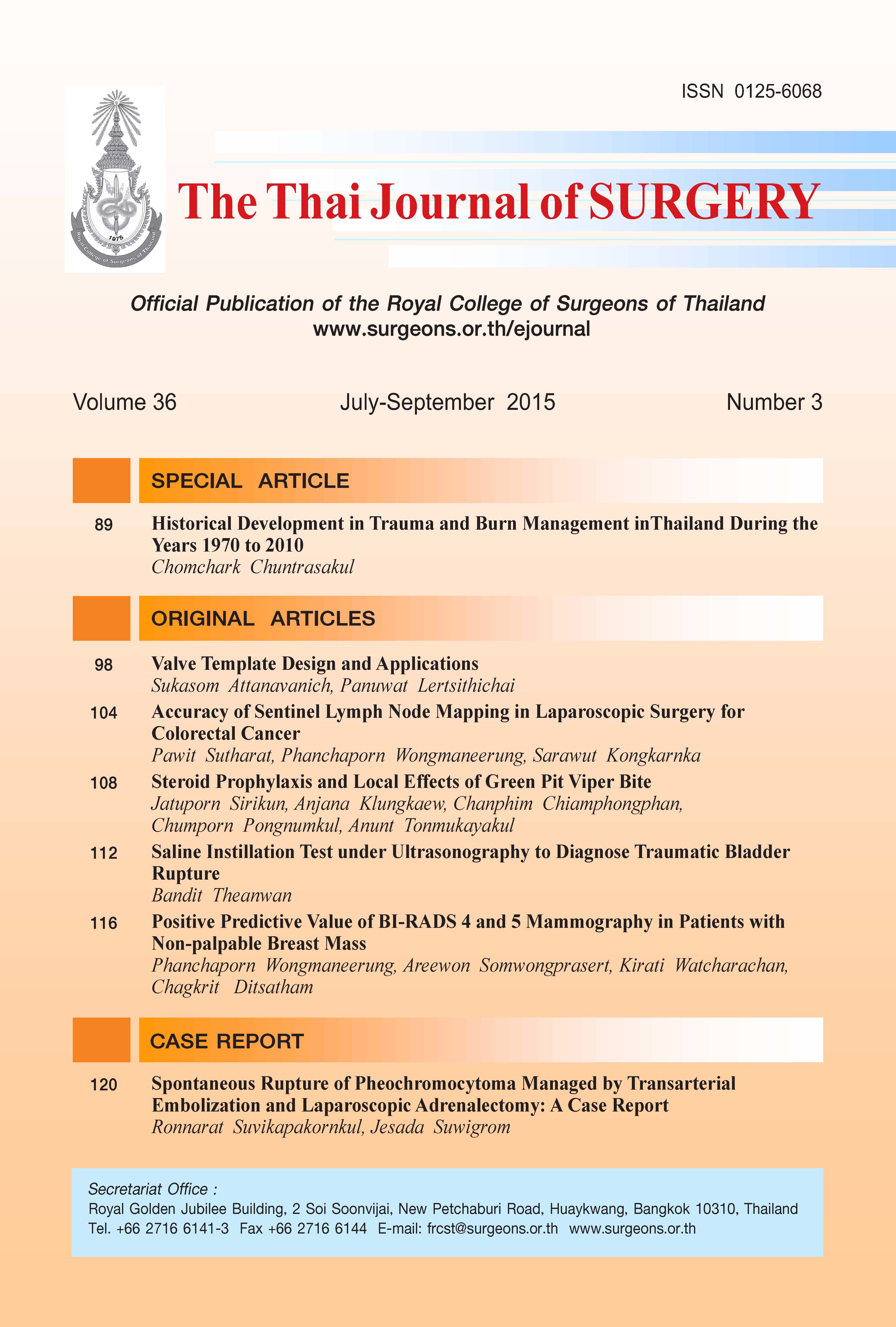Positive Predictive Value of BI-RADS 4 and 5 Mammography in Patients with Non-palpable Breast Mass
Keywords:
Non-palpable breast mass, BI-RADS category 4 & 5, positive predictive valueAbstract
Background and Objective: Breast cancer is the most common cause of death in Thai women. The BIRADSsystem is commonly used to categorize the risk of cancer for breast lesions seen on mammography and breast
ultrasound. BI-RADS 4 category indicates a cancer risk of 2% to 95% and for BIRADS 5 the risk is over 95%. Most
breast lesions found on screening mammogram are non-palpable. The purpose of this study was to determine the
positive predictive value (PPV) of non-palpable breast lesions classified as BIRADS 4 or 5, to help decide whether
excisional biopsy is worth doing at Chiang Mai University Hospital.
Materials and Methods: This retrospective study collected data from a hospital database (Digicard) from
January 2009 to December 2014. We reviewed the indications for mammography, radiologic findings, BIRADS
category, and pathology, and calculated the PPV.
Results: There were 168 women who underwent radiology-guided excision of non- palpable breast lesions
during the study period. These lesions were detected by screening (43%), surveillance (10%), and diagnostic
mammograms (46%). Of the 171 lesions identified, 145 (85%) were BIRADS 4, and 13 (8%) were BIRADS 5.Twentynine
of the BIRADS 4 lesions (PPV 20%) and 13 of the BIRADS 5 lesions (PPV 77%) were malignant. The most
common radiographic finding for invasive cancers was speculated mass, and for DCIS, microcalcifications.
Conclusion: Non-palpable breast lesions detected by mammography had a 20% malignancy risk if categorized
as BIRADS 4, and 77% if categorized as BI-RADS 5. Spiculated mass and microcalcifications were radiologic findings
highly associated with cancer. For a benign lesion with radiologic findings of malignancy, a radiology-guided biopsy
is still recommended.
References
Bangkok: Department of Medical Services, Ministry of Public
Health, Thailand; 2012.
2. D’Orsi CJ, Bassett LW, Berg WA, et al. Breast Imaging Reporting
and Data System: ACR BI-RADS-Mammography. 4th ed.
Reston, VA: American College of Radiology; 2003.
3. Gweon HM, Son EJ, Youk JH, et al. Value of the US BI-RADS
final assessment following mastectomy: BI-RADS 4 and 5
lesions. Acta Radiol 2012;53:255-60.
4. Khan S, Mitha N, Kazi F, Siddiqui M. Needle localization of
non-palpable breast lesions. J Pak Med Assoc 1996;46:149-
52.
5. Leinung S, W_rl P, Preusse C, et al. Quality assurance in
excision of suspected malignant, preoperatively marked
and unmarked,breast lesions. A one-year analysis.
Zentralblatt für Chirurgie 2000;125 Suppl 2:182-4.
6. Schaefer FK, Eden I, Schaefer PJ, et al. Factors associated
with one step surgery in case of non-palpable breast cancer.
Eur J Radiol 2007;64:426-31.
7. Liberman L, Abramson AF, Squires FB, et al. The breast
imaging reporting and data system: positive predictive
value of mammographic features and final assessment
categories. AJR 1998;171:35-40.
8. Lacquement MA, Mitchell D, Hollingsworth AB. Positive
predictive value of the Breast Imaging Reporting and Data
System. J Am Coll Surg 1999;189:34-40.
9. Muttarak M, Srivichai K,Chaiwun B,Sukhamwang N. The
Breast Imaging Reporting and Data System - BIRADS: Positive
predictive value of catagories 4 and 5 lesions. Chiang Mai
Med J 2010;49:111-6.
10. Thinyu S. Positive predictive value of mammographic report
BI-RADS Category 4 and 5 correlating with pathologic result
in lampang hospital. Lampang Med J 2012; 33:115-26.
11. Zhu QL, Jiang YX, Zhang J, et al. Sonographic features of
Breast Imaging Reporting and Data System assessment
Category 4 and 5 non-palpable breast lesions. Acta
Academiae Medicinae Sinicae 2010:456-60.
Downloads
Published
How to Cite
Issue
Section
License
Articles must be contributed solely to The Thai Journal of Surgery and when published become the property of the Royal College of Surgeons of Thailand. The Royal College of Surgeons of Thailand reserves copyright on all published materials and such materials may not be reproduced in any form without the written permission.



